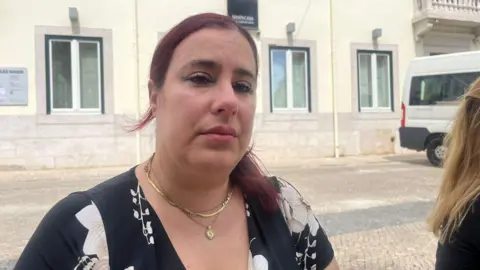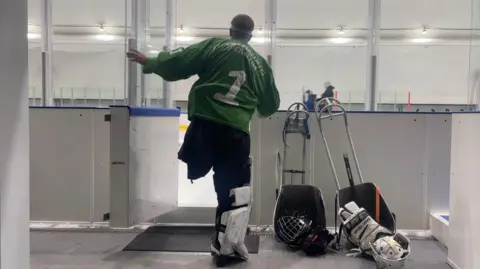DALLAS (AP) — In the decades since June West Brandt’s older brother was killed in World War II, her kind and artistic sibling who loved to play boogie-woogie on the piano has never been far from her mind. So she was delighted to discover he’s also being remembered by a Dutch couple who regularly visit a marker for him at a Netherlands cemetery. “It’s wonderful for me to know that someone is there,” said Brandt, 93, who lives near Houston.
Her introduction over the summer to Lisa and Guido Meijers came by way of a new initiative aiming to increase the number of connections between the family members of those buried and remembered on the walls of the missing at the World War II cemetery and the Dutch people who have adopted each one.
The project was spurred on by “The Monuments Men” author Robert Edsel, whose newest book, “Remember Us,” tells the story of the adoption program at the Netherlands American Cemetery. His Dallas-based Monuments Men and Women Foundation teamed with the Dutch foundation responsible for the adoptions to create the Forever Promise Project, which has a searchable database of the names of U.S. service members buried and remembered at the cemetery.
“I’d like us to find and connect as many American families to their Dutch adopters as is possible,” Edsel said.
Ton Hermes, chairman of the Foundation for Adopting Graves American Cemetery Margraten, said that while each of the about 8,300 graves and 1,700 markers for the missing at the cemetery near the village of Margraten have adopters, only about 20% to 30% of them are in contact with the service member’s relatives.
When the Meijerses adopted the marker for Army Air Forces Staff Sgt. William Durham “W.D.” West Jr. several years ago, they knew only basic information about the 20-year-old whose body was never recovered after his B-24 bomber was shot down over the North Sea on a mission into Nazi Germany.
Through talking with Brandt, they’ve learned that West was “quite a creative soul,” Lisa Meijers said. “That obviously makes a huge change in how to remember someone,” she said. Brandt said her brother loved to paint and played the piano by ear, and even though she was six years younger, they were “big buddies” growing up in the small western Louisiana city of DeRidder.
Brandt’s daughter, Allison Brandt Woods, said it’s heartwarming knowing Meijerses are watching over the marker. Woods met up with them on a recent trip and hopes the connection between their families will continue with future generations.
The cemetery, Lisa Meijers said, is among many reminders of World War II in the southern Netherlands, which was liberated by Allied forces in September 1944 after over four years of Nazi occupation. “We just really feel how extremely important it is to remember these things and to honor the sacrifices these people made for us,” she said. The Meijerses, who have a 1-year-old son, visit West’s marker about once a month, bringing flowers.
Hermes said the program is so popular that there’s a waiting list to adopt a grave or marker. Names on the walls for the missing were opened up for adoption in 2008, said Frans Roebroeks, secretary for the Dutch adoption foundation. The formal adoption process for graves began to take shape during a 1945 meeting of the Margraten town council. “They were meeting to figure out the answer to the question: How do you thank your liberators when they are no longer alive to thank?” Edsel said.
Many initial adopters took on the grave of someone they had gotten to know. “Once they heard their soldier was killed in action, the Dutch people decided to adopt his grave, to bring flowers and to correspond with the wives or mothers in the United States,” Hermes said. Roebroeks said many of the graves have been cared for by the same family since the end of the war, including one that’s been passed down through his family. He said Army Pfc. Henry Wolf had stayed at his grandfather’s farm and became “like a son” to him. Wolf’s grave has passed from Roebroeks’ grandfather to his mother and now to his sister, who will pass it to her daughter, he said. “That grave stays in the family,” he said. Edsel said that so far, over 300 families have asked to be put in touch with their adopters. “And we’re just starting,” he said.
Her introduction over the summer to Lisa and Guido Meijers came by way of a new initiative aiming to increase the number of connections between the family members of those buried and remembered on the walls of the missing at the World War II cemetery and the Dutch people who have adopted each one.
The project was spurred on by “The Monuments Men” author Robert Edsel, whose newest book, “Remember Us,” tells the story of the adoption program at the Netherlands American Cemetery. His Dallas-based Monuments Men and Women Foundation teamed with the Dutch foundation responsible for the adoptions to create the Forever Promise Project, which has a searchable database of the names of U.S. service members buried and remembered at the cemetery.
“I’d like us to find and connect as many American families to their Dutch adopters as is possible,” Edsel said.
Ton Hermes, chairman of the Foundation for Adopting Graves American Cemetery Margraten, said that while each of the about 8,300 graves and 1,700 markers for the missing at the cemetery near the village of Margraten have adopters, only about 20% to 30% of them are in contact with the service member’s relatives.
When the Meijerses adopted the marker for Army Air Forces Staff Sgt. William Durham “W.D.” West Jr. several years ago, they knew only basic information about the 20-year-old whose body was never recovered after his B-24 bomber was shot down over the North Sea on a mission into Nazi Germany.
Through talking with Brandt, they’ve learned that West was “quite a creative soul,” Lisa Meijers said. “That obviously makes a huge change in how to remember someone,” she said. Brandt said her brother loved to paint and played the piano by ear, and even though she was six years younger, they were “big buddies” growing up in the small western Louisiana city of DeRidder.
Brandt’s daughter, Allison Brandt Woods, said it’s heartwarming knowing Meijerses are watching over the marker. Woods met up with them on a recent trip and hopes the connection between their families will continue with future generations.
The cemetery, Lisa Meijers said, is among many reminders of World War II in the southern Netherlands, which was liberated by Allied forces in September 1944 after over four years of Nazi occupation. “We just really feel how extremely important it is to remember these things and to honor the sacrifices these people made for us,” she said. The Meijerses, who have a 1-year-old son, visit West’s marker about once a month, bringing flowers.
Hermes said the program is so popular that there’s a waiting list to adopt a grave or marker. Names on the walls for the missing were opened up for adoption in 2008, said Frans Roebroeks, secretary for the Dutch adoption foundation. The formal adoption process for graves began to take shape during a 1945 meeting of the Margraten town council. “They were meeting to figure out the answer to the question: How do you thank your liberators when they are no longer alive to thank?” Edsel said.
Many initial adopters took on the grave of someone they had gotten to know. “Once they heard their soldier was killed in action, the Dutch people decided to adopt his grave, to bring flowers and to correspond with the wives or mothers in the United States,” Hermes said. Roebroeks said many of the graves have been cared for by the same family since the end of the war, including one that’s been passed down through his family. He said Army Pfc. Henry Wolf had stayed at his grandfather’s farm and became “like a son” to him. Wolf’s grave has passed from Roebroeks’ grandfather to his mother and now to his sister, who will pass it to her daughter, he said. “That grave stays in the family,” he said. Edsel said that so far, over 300 families have asked to be put in touch with their adopters. “And we’re just starting,” he said.




















